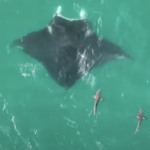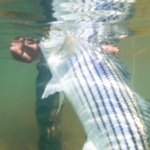
Veteran Florida Guides Concerned About False Albacore
While the ASGA team is extremely proud of the community we’re building with the Guide
We wrote about the issues with bluefish in our blog about a month ago. https://saltwaterguidesassociation.com/lets-not-forget-about-bluefish/
The Mid-Atlantic Fishery Management Council is moving swiftly to address the overfished status of bluefish. At the October meeting, the MAFMC set the recreational harvest limit for 2020 at 9.48 million pounds, a 28.78% reduction from the 13.27 million pound harvest in 2018. We can expect new regs for the 2020 season and we are most likely looking at moving from a 15 fish limit to a 3 fish limit. No one really keeps 15 bluefish, the current creel limit. To achieve an almost 30% reduction, the creel limit must be dramatically reduced.
Quote
Staff Recommendations
The Council approved expected recreational landings of 13,270,862 pounds is 28.56% higher than the 2020 RHL of 9,480,162 pounds. Thus, staff recommends a coastwide 3-fish bag limit to constrain harvest by 28.78% (no discards) so that the 2020 recreational harvest does not exceed the RHL.”
Why such swift action? Well, because bluefish are managed under the Magnuson-Stevens Act (MSA) which has requirements for rebuilding overfished stocks and accountability measures when a sector doesn’t meet those requirements.
We will get into the specifics in the next few paragraphs. For now, let that sink in. The number two most popular fish on the east coast, bluefish, are overfished and we are seeing swift and decisive action. The number one fish on the east coast, striped bass, are overfished and overfishing is occurring (worse), and we watch a dumpster fire combined with a demolition derby unfold. The curse of ASMFC continues.
Under MSA, the MAFMC must develop a fishery management plan within two years of determining an overfished status and the FMP must rebuild the stock within ten years. The MAFMC also has to immediately restrict the fishery for the 2020 season. The stock also has to be rebuilt to the target and not the threshold. That’s a big difference
Since no one keeps 15 bluefish anymore, a 28.56% reduction requires a significant creel reduction. Once the FMP is developed by 2022, you can expect even more restrictions in harvest because bluefish must return to target.

There are other options on the table like season restrictions and minimum size requirements. However, limiting the season will benefit certain states. Bluefish migrate right? If we limit the summer season, the Northeast will pay. If we limit the winter, the South will bear the brunt of the burden. If we move the minimum size up to, let’s say 19”, that won’t be great either. Most folks like keeping smaller ones. The big ones don’t have a high value for the table.
So, what are the key differences here? First, swift action. We knew striped bass would be overfished and didn’t do a thing about it for years. Second, coastwide limits. That’s right folks, the three fish bag, possible season restrictions, and possible new minimum size would all be coastwide. That was the number one comment from our angler workshops. People want standard limits for striped bass. None of the conservation equivalency nonsense that will most likely damage the striped bass population further. Finally, we can expect to see a 10 year rebuilding plan. Not 13 years, like in the case of Amendment VI for striped bass, but a hard 10 year timeline will be in place. Finally, accountability will make the council take a more risk-averse approach to bluefish. Why? Because if the rec sector goes over the 9 million pound harvest in 2020, there will be pound for pound paybacks in 2021. If we are going to 3 fish in 2020, can you imagine the cuts in 2021 if we have to payback? You see, if sectors are actually penalized for overfishing, (note Maryland getting away with murder for striped bass) then the managers actually do the right thing the first time. Finally, there is accountability for the Councils. If they break the rules, they can be sued. If ASMFC breaks the rules, well, it is just another Tuesday.
Here’s the language on payback provisions.
If biomass is below the threshold, the stock is under rebuilding, or biological reference points are unknown. If the most recent estimate of biomass is below the BMSY threshold (i.e., B/BMSY is less than 0.5), the stock is under a rebuilding plan, or the biological reference points (B or BMSY) are unknown, and the ACL has been exceeded, then the exact amount, in pounds, by which the most recent year’s recreational catch estimate exceeded the most recent year’s ACL will be deducted from the following year’s recreational ACT, or as soon as possible thereafter, once catch data are available, as a single-year adjustment. If the ACL has been exceeded. If the ACL has been exceeded, then adjustments to the recreational management measures, taking into account the performance of the measures and conditions that precipitated the overage, will be made in the following fishing year, or as soon as possible thereafter, once catch data are available, as a single-year adjustment.
Now, how do you feel about all that talk regarding conservation equivalency being a good thing? Can states manage fisheries better than Magnuson? When you see the stark difference between the swift action taken on bluefish and the slow motion carnival unfolding for striped bass, we don’t need to say much more. Conservation equivalency is being used in the wrong manner. States are subject to wild administration swings. If one state has a new Governor and that Governor decides to do whatever it takes to harvest more (Governor Hogan in Maryland), the rest of the coast will pay the price. That doesn’t seem fair, does it? This is why you can’t allow a state to have too much power (CE) when dealing with migratory stocks. You want to manage largemouth bass, go for it! Striped bass should be managed with a better framework.
When ten year rebuilding timelines are mandatory. When pound for pound paybacks are in effect. When limits are coast wide and not a hodgepodge of insanity to thinly veil the desire to kill more fish. When swift action isn’t a choice, it is a requirement. Well…then and only then can you look at management action and say, “You know what, this might actually work.”
Looks like we might be catching decent numbers of bluefish again in the next few years. Too bad we aren’t so sure about striped bass.

While the ASGA team is extremely proud of the community we’re building with the Guide

Feature Image: A false albacore being landed off Jupiter Florida by the Cheeky Fishing team,

Feature Photo: “Best Practices for Fishing Cobia Around Manta Rays” The Florida Manta Project is

We caught this article a few days ago. Here’s the summary: Maryland striped bass commercial
We rely on our members and donations to keep fighting for a sustainable tomorrow in marine conservation.
By using this website, you agree to our use of cookies. We use cookies to provide you with a great experience and to help our website run effectively. To learn more, please review our privacy policy.
6 Responses
So, how do we get ASMFC to abide by Magnuson rules? Keep up the good work.
I hope that things will change and CE are a thing of the past, can’t have a free for all out there to make the Regs favor certain States.
We need to make sure that during the amendment period states dont try to lower reference points. This will give the state’s an out and eliminate the hard work it will take to return Striped Bass to the abundance level regulators, the fishing industry and recreational anglers defined as the optimal level for all! Lets not let them change the end zone!
Please tell me when and in what States allowed a fifteen fish bag limit on blue fish .I was wondering if that was for recreational or for commercial fishermen. Massachusetts has a 10 fish limit on Blue fish a day.
https://www.fisheries.noaa.gov/species/bluefish#recreational
I was always under the impression that was 15 for the “snapper” fisherman. Lots of guys catch then and use them for fluke bait. Kids also catch them a fill a bucket for no reason, other than no one told them not to.